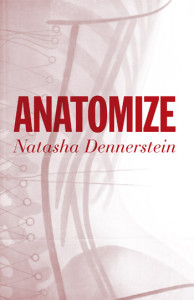Anatomize, by Natasha Dennerstein. Norfolk Press, 2015. $15, 73 pages.
“Nothing is beautiful, only people are beautiful,” Friedrich Nietzsche observed in Twilight of the Idols. The German philosopher believed that beauty in nature was derived from the beauty we find in ourselves. Aesthetic judgments simply confirmed that people “themselves have given the world its beauty,” and that “Fundamentally, humanity is reflected in all things.” For Nietzsche, “the judgment ‘beautiful’ is the vanity of their species.“
In Anatomize, her first collection of poetry, Dennerstein responds to Nietzsche. The poem “Strawberry Blonde,” for example, points out inconsistencies in the human perceptions of beauty.
If the bloodyolk sun
to be found at the heart
of the variegated nasturtium
is beautiful;…
the piebald Palomino
and the brindled black-and-tan,
slick-sided thoroughbred
are beautiful;
then why is the vitiligo-patched
skin of the freckle-faced girl
speckled shell-pink, brown
not considered beautiful?
Dennerstein asks why, if we find variegation—irregular patches of color—beautiful in nature, it’s not considered beautiful in people? Instead of freckles, “perfection is expected / in the human complexion,” and cultural standards define perfection, the poet implies, as an unbroken palette. Anatomize moves from freckles to scars to skin grafts to skeletons. Throughout, Dennerstein investigates the human body and finds beauty in unexpected places.
Amidst a series of poems on hair is “Bitches,” a found-word prose poem that collages the descriptions of hue on hair coloring packages. The voice of Brunette announces, “I rake my espresso, chestnut locks with my bare fingers… I am mahogany: watch me grow strong in the forest, watch me remain standing.”
Dennerstein’s book has poems of personal power and loss, of grief and sexual excitement. There are no anatomical parts off limits, and as if to make the point, she pairs two poems on facing pages titled “Pussy” and “Boner.” A poem of skin includes breasts —”once juicy peaches – now pomegranates held in kidskin sacs.” Throughout, Dennerstein finds a common humanity. After all, what is more common than our embodiment?
That each of us has skin and teeth and genitals and blood. That the look, utility, and display of these is unique in our bodies. That we are composed of the same elements. That the brain is the “meaty cauliflower inside my skull / synapses a-go-go like a disco light show” (“Cerebral”). That the cerebellum, the heart, amniotic sac and even the thyroid and gall bladder take turns as the subject of verse.
With epigraphs from Silvia Plath, Anne Sexton, and Lady Macbeth and references within poems to Ophelia, Wild Turkey, Velcro, matryoshka dolls, and Volkswagens, Anatomize will appeal to contemporary readers who are familiar with the elliptical inclusion of high and pop culture. The rhythms Dennerstein forms oscillate between the present and past—or, as in “iris, pupil, cornea,” between Google Glasses and the Duke of Cornwall from Shakespeare’s King Lear. This play would make a reader dizzy in the hands of a less talented poet.
Dennerstein grounds her work in the sensuality of sensuality. The variety of poetic forms throughout Anatomize tickle the intellect. Occasionally, the titles give away their constructions, as is the case with “Voodoo Villanelle” and “Ghazal for the Nail Artist.” At other times, the poem’s form is more subtle. “Honeyman,” a pantoum of the heart opens with a number: “Sixty-six times every minute / her muscular heart makes a fist; it clenches.”
But there is nothing natural or sacred about the body with which we are born. Tattoo artist and addict meet in “Orchidlegs & Daggerheart,” where Dennerstein’s sense of the visual comes to life:
He crimson hearts her, cobalts
and emeralds her canvas leg. Panther
rampant leaps up to her crotch.
In “Second Skin,” a love poem of facial reconstruction, “the whitecoats took grafts from the backs of your thighs and arms—cigarette-packet sized—slapped them on your face.” But in “Choreography of Skeletonism,” the poet imagines that sometimes we have the instinct to deconstruct our bodies, to take off more than just our clothes:
You want to strip off your skin,
ttsuck off your Velcro tabs
and fling your epidermis panels
into the lap-dance audience. You
want to divest yourself of muscle, peel
that meat away. You have a strong desire
to sashay around in your bones, to
see them work it in X-ray vision —
neon ultramarine in an on-screen
regime…
The assonance and internal rhyme—away, sashay; marine, on-screen, regime—in the book’s third poem “Choreography of Skeletonism” introduce the reader to Dennerstein’s sense of sound, which runs throughout Anatomize. When tympanic, eustachian tube, auditory cortex, and cartilaginous auricle all show up in “Listen to me, escúchame, hôr zu!” Dennerstein’s diction challenges the reader to hear beauty in the precise scientific terms of anatomy.
With wit and sure-footed intelligence, her poems also treat the reader to lessons in humility. The poem “Oxygenate” uses tight enjambment to perform the simple, semi-conscious act of breathing:
Bicycle
pump those inner-tubes
with your inflated sense
of self: just breathe.
In “decompose,” the poet’s choice not to capitalize the title underscores the harsh reality that for each of us, our subjectivity is tied to a clock that is winding down. We will all, one day,
feed the clay
nourish the mud
it’s the most
useful thing
I’ve ever done.
Romanticism tells us each that our own point of view is unique among people. German philosophers argue that human rationality is our most god-like feature. Anatomize reminds the reader that, not only do we all have blood, organs, and skeletons in our bodies, but all of us are also made of the same stuff, the same materials of the universe.
Phillip Barron’s first book of poetry, What Comes from a Thing, won the 2015 Michael Rubin Book Award and was published by Fourteen Hills Press of San Francisco.

